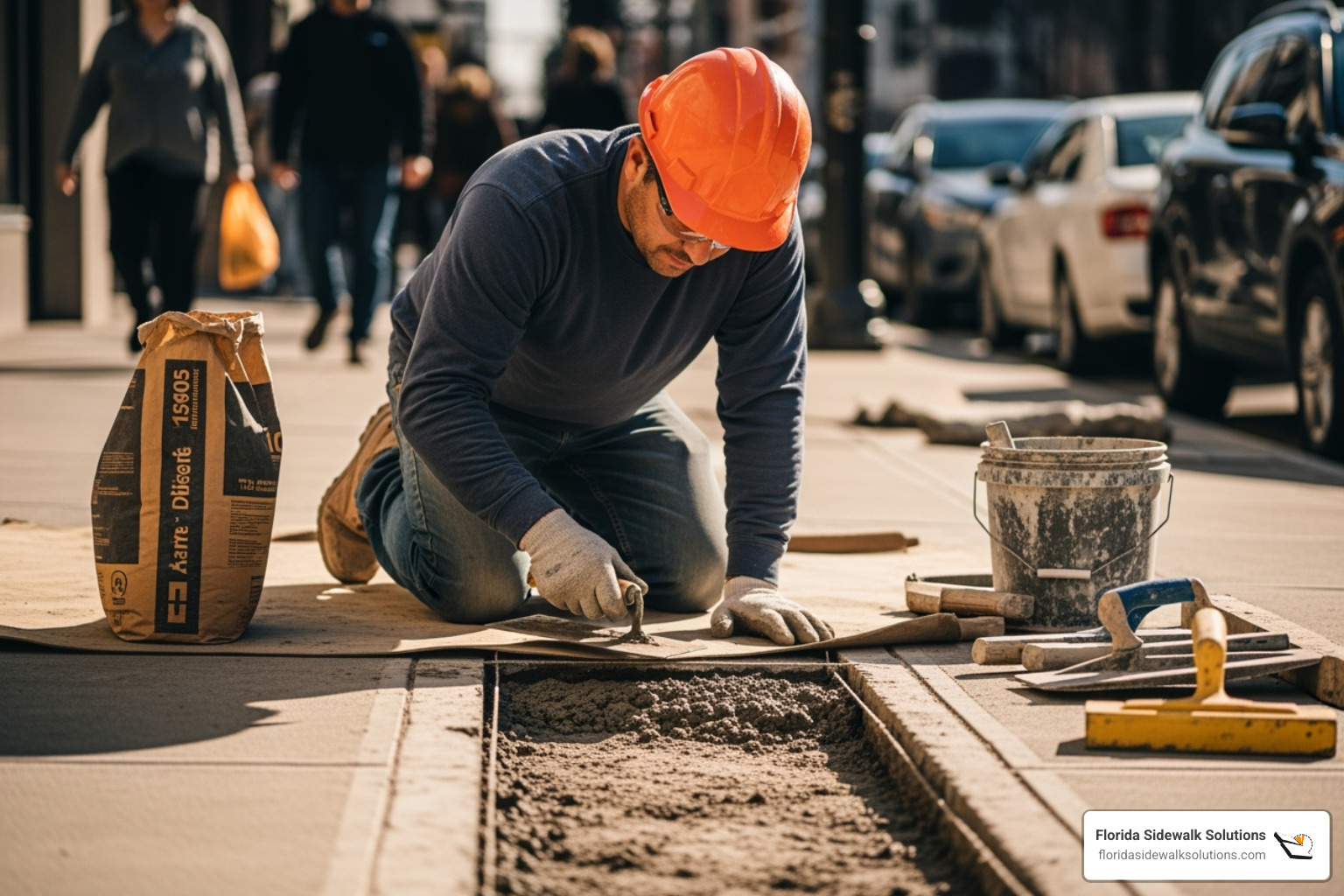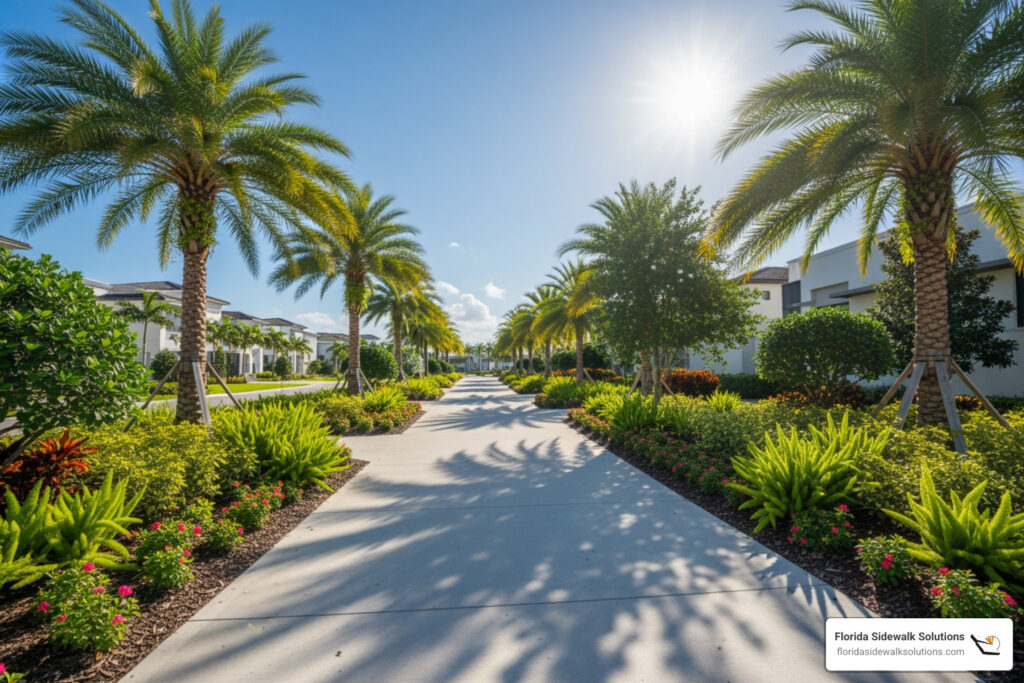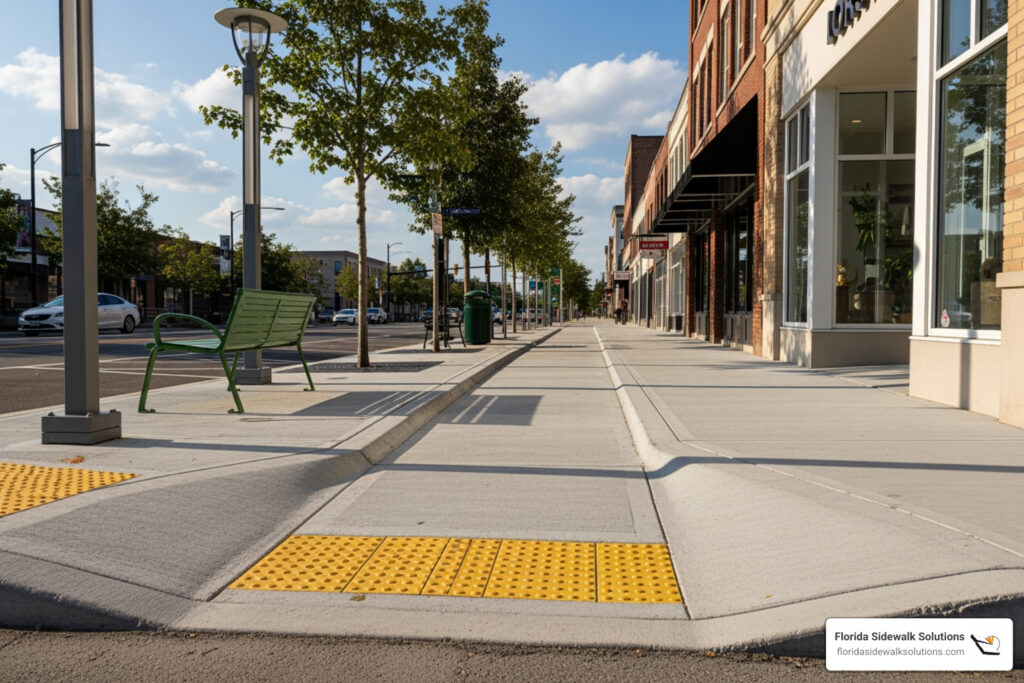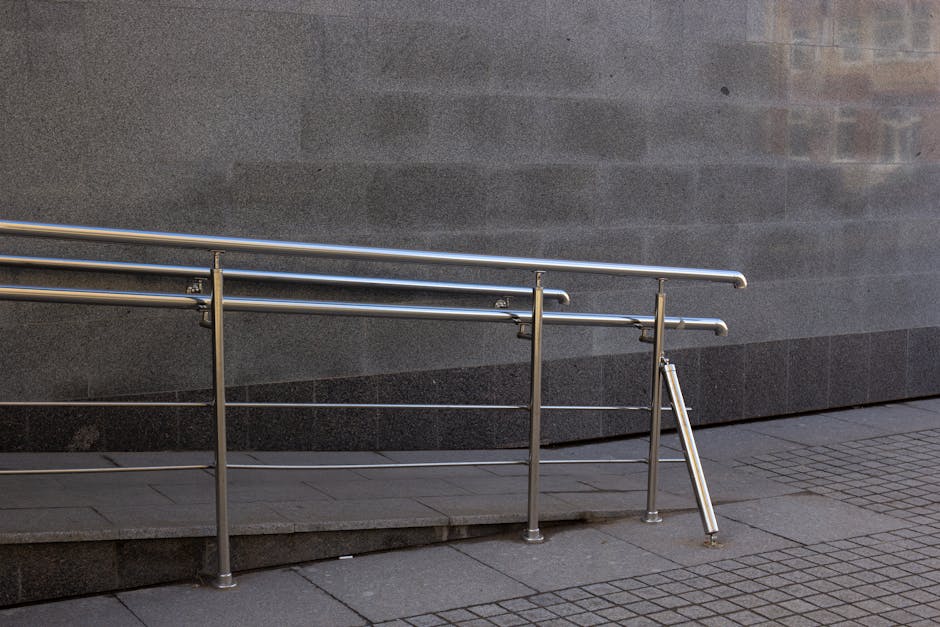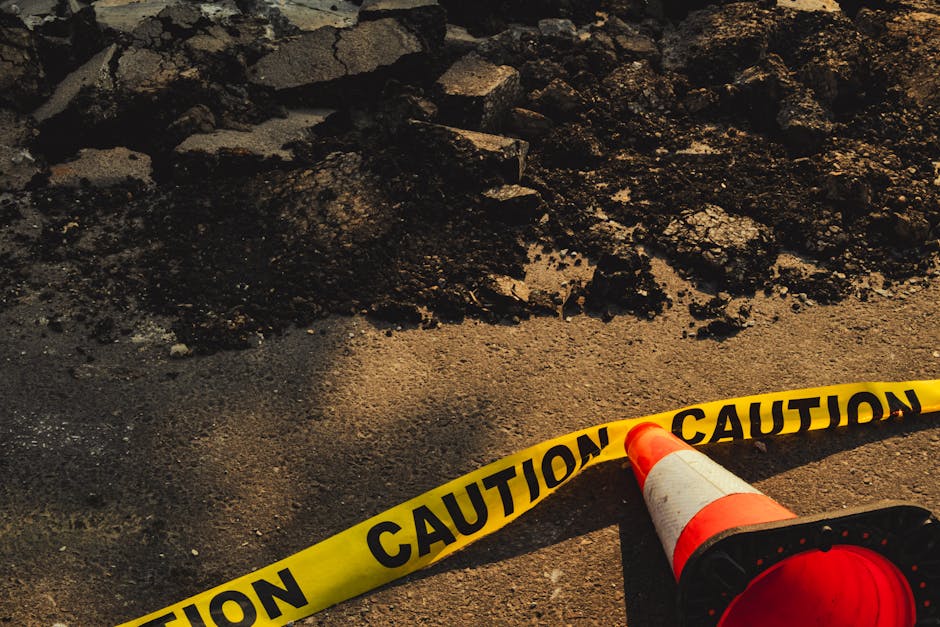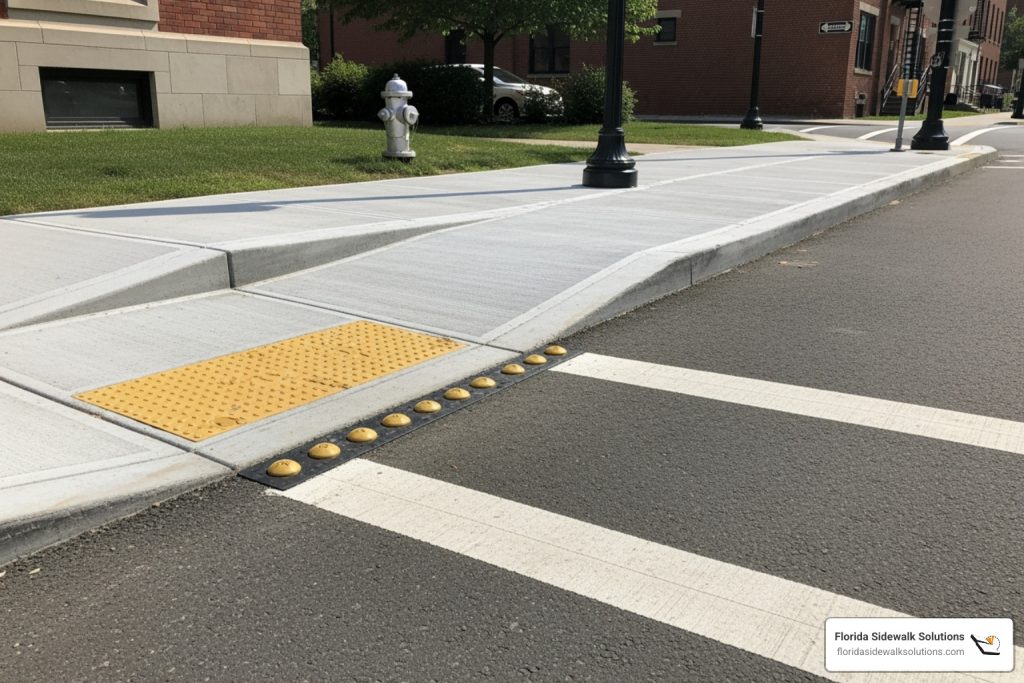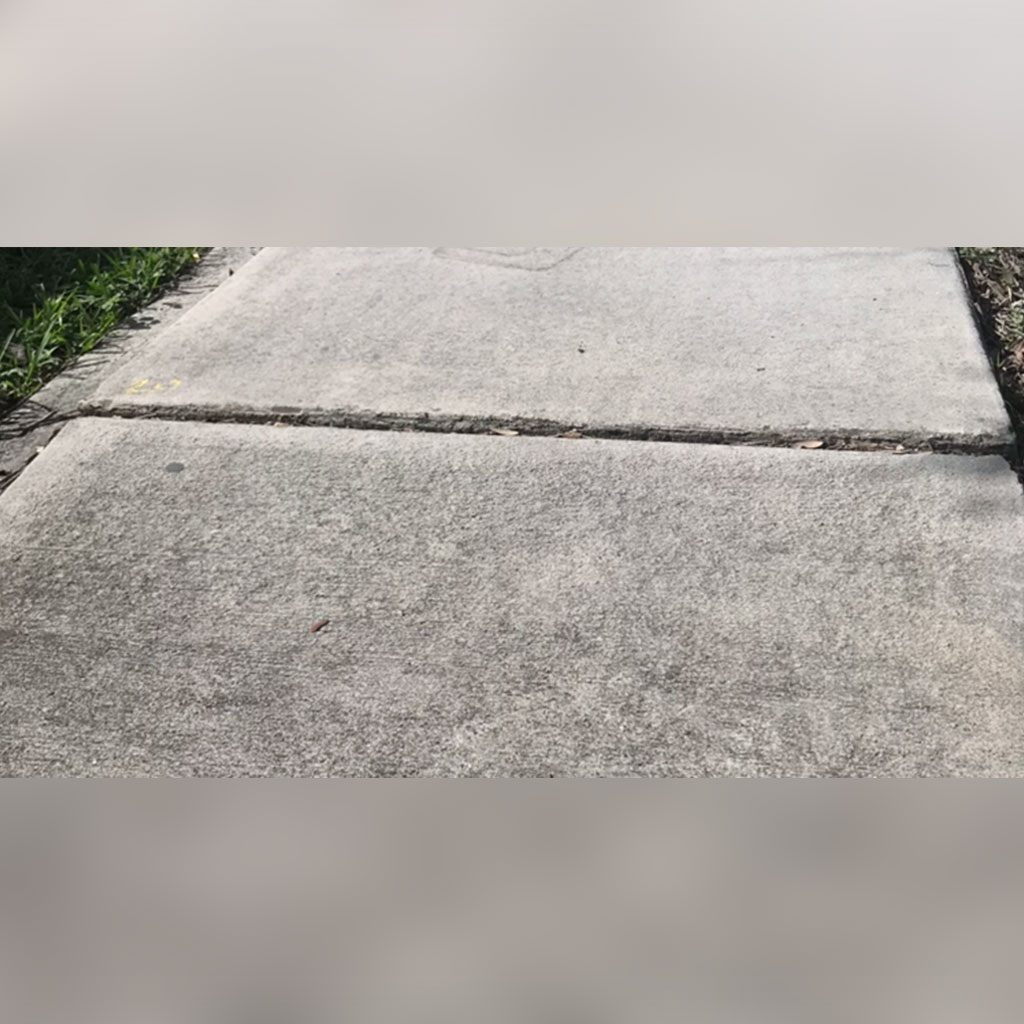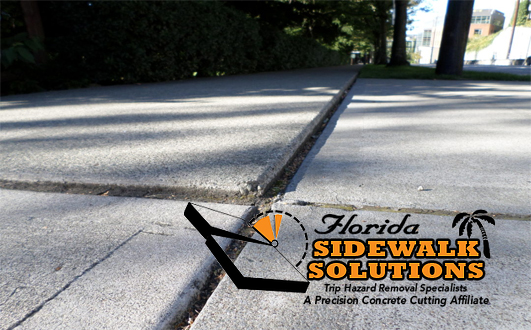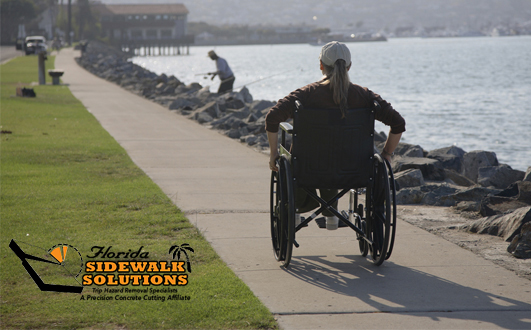Why Proper Concrete Work Near Me Matters for Municipal Safety
Finding reliable concrete work near me starts with understanding what you actually need. For municipal maintenance managers, this typically means addressing sidewalk trip hazards that create liability issues and violate ADA compliance standards.
Quick Answer for “Concrete Work Near Me” Search:
- Trip Hazard Definition: Any vertical change of 1/4 inch or more at sidewalk joints or cracks (per ADA standards)
- Best Solution: Precision concrete cutting to level uneven slabs
- Cost Savings: Up to 90% less expensive than full removal and replacement
- Timeline: Immediate walkway use after repair (no curing time)
- Key Benefit: Maintains existing sidewalk while eliminating liability
Uneven sidewalks represent more than just an eyesore – they’re a legal liability that can cost municipalities thousands in lawsuit settlements. The Americans with Disabilities Act defines a “trip hazard” as any vertical change of 1/4 inch or more at any joint or crack, making compliance both a safety and legal necessity.
Traditional methods like concrete grinding, scabblers, or complete removal and replacement often fall short. Concrete grinding can’t reach sidewalk edges effectively, leaving trip hazards intact. Full replacement is expensive and disruptive, requiring weeks of curing time and pedestrian detours.
Modern precision concrete cutting technology offers a better solution. This patented approach cuts concrete sidewalks to make them perfectly level – more effectively and economically than conventional methods. The result? ADA-compliant walkways that eliminate trip hazards while preserving your existing concrete investment.
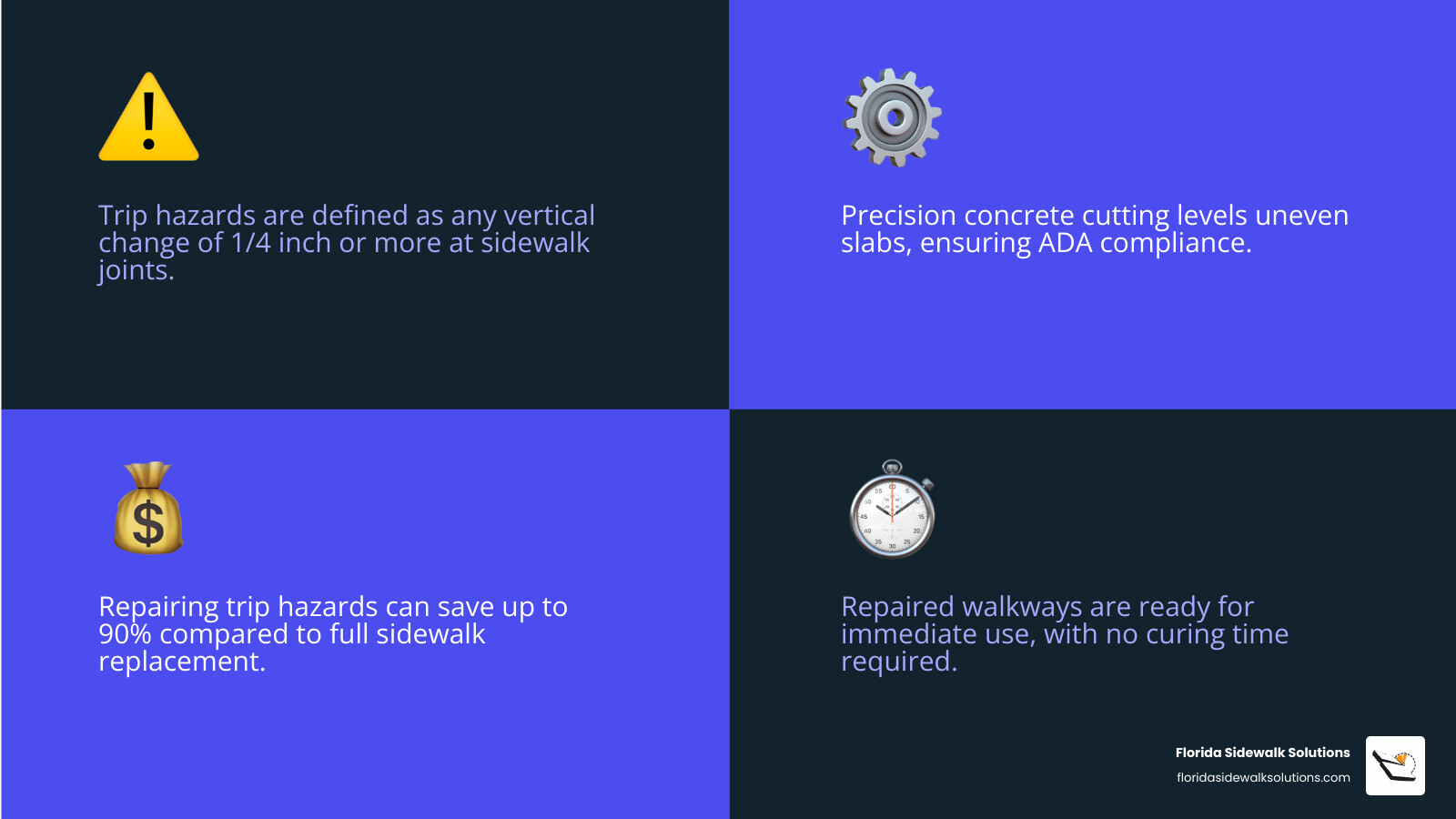
Key terms for concrete work near me:
Signs Your Concrete Sidewalk Needs Professional Trip Hazard Repair
You know that feeling when you’re walking along a sidewalk and suddenly catch your toe on an uneven slab? That jarring stumble isn’t just annoying – it’s a clear sign that the concrete needs professional attention. When property owners search for concrete work near me, they’re often dealing with these exact safety hazards that put pedestrians at risk and create liability issues.
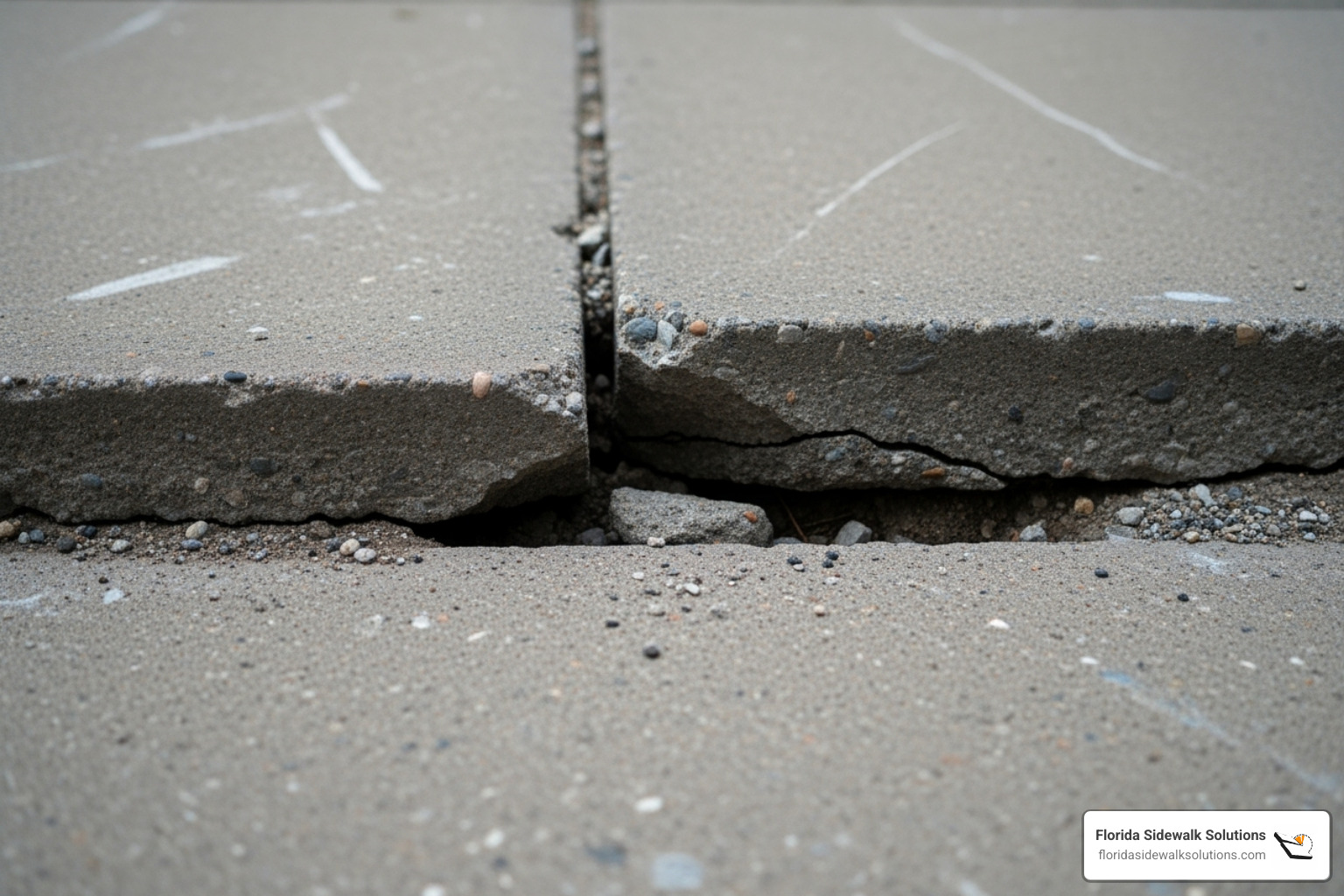
The most obvious warning sign is uneven slabs where one section of concrete has shifted higher or lower than its neighbor. According to the Americans with Disabilities Act, any vertical change over 1/4 inch officially qualifies as a trip hazard. This isn’t just a guideline – it’s a legal standard that can expose property owners to costly lawsuits if ignored.
Sunken concrete creates another dangerous scenario. When sections of sidewalk sink below the surrounding level, they form unexpected drop-offs that can send someone tumbling. This sinking usually happens because the ground beneath wasn’t properly prepared during installation, or the soil has shifted over time. The problem gets worse when water pools in these low spots, gradually weakening the concrete further.
Watch out for crumbling edges along your sidewalk slabs. While concrete naturally ages, significant deterioration around the edges signals trouble. These weakened areas can break away underfoot, creating unstable walking surfaces. Sometimes this happens because the original concrete mix wasn’t quite right, but more often it’s simply the result of decades of weather exposure and daily wear.
Wide cracks tell a different story than those hairline fractures you might see in newer concrete. When cracks exceed 1/4 inch in width or depth, they indicate underlying structural problems. These gaps collect debris and water, which freezes and expands during colder months, making the damage progressively worse.
If you notice water pooling on your sidewalk long after the rain stops, that’s concrete speaking to you. Proper sidewalks should drain efficiently, so standing water means the surface has become uneven enough to trap moisture. This creates slippery conditions and accelerates concrete deterioration as water seeps into existing cracks.
Identifying these issues early helps maintain public safety and keeps your property compliant with ADA standards. For detailed compliance information, check out Understanding ADA compliance.
When to Repair vs. Replace Your Sidewalk
Here’s the good news: most sidewalk trip hazards don’t require tearing out and replacing entire sections of concrete. The lifespan of concrete typically ranges from 30 to 50 years, and with proper maintenance, it can last over a century. Unless your sidewalk dates back to the Eisenhower administration or shows widespread structural failure, targeted repair makes much more sense.
Minor damage like isolated raised slabs or localized cracks responds beautifully to precision repair techniques. Our specialized cutting method addresses the specific trip hazard without disturbing the surrounding concrete that’s still perfectly sound. This approach costs significantly less than replacement while solving the safety problem immediately.
The cost-effectiveness of repair becomes obvious when you run the numbers. Traditional methods like concrete grinding often can’t reach sidewalk edges effectively, leaving trip hazards partially intact. Full replacement involves expensive demolition, disposal, new concrete, and weeks of curing time while pedestrians steer detours.
Our patented cutting technology eliminates these problems entirely. The repair costs roughly one-tenth of full replacement, and the sidewalk is ready for immediate use. No curing time, no extended closures, no massive expense.
Structural integrity rarely requires complete replacement for typical trip hazards. When tree roots push up a single slab or settling creates one uneven joint, the rest of your concrete remains structurally sound. Why replace good concrete along with the problematic section?
Assessing liability risks should focus on eliminating the hazard quickly and cost-effectively. Every day that trip hazard remains increases your exposure to potential lawsuits. Our targeted approach removes the danger immediately while maintaining ADA compliance, protecting both pedestrians and property owners without the disruption and expense of full replacement.
The bottom line? Targeted trip hazard removal preserves your concrete investment while solving the safety problem efficiently. It’s the smart choice for most sidewalk issues, delivering better results faster and more affordably than traditional approaches.
Understanding Sidewalk Trip Hazard Removal Methods
When searching for concrete work near me for sidewalk repairs, you’ll quickly find that not all methods are created equal. At Florida Sidewalk Solutions, we’ve revolutionized sidewalk trip hazard removal with our patented precision concrete cutting technology that addresses the root problem more effectively than traditional approaches.
Most property managers have encountered the frustration of conventional repair methods. Traditional scabblers and concrete grinders often promise level surfaces but fall short in practice, particularly when it comes to reaching sidewalk edges where many trip hazards occur. Full removal and replacement seems thorough but brings its own headaches: weeks of unusable walkways, expensive material costs, and the disruption that comes with major construction.
Our precision concrete cutting method changes the game entirely. Instead of grinding down surfaces or tearing out perfectly good concrete, we use specialized technology to cut uneven slabs to create perfectly level surfaces. This isn’t just another repair technique – it’s a complete rethinking of how sidewalk trip hazards should be addressed.
The advantages become clear immediately. There’s no curing time required, which means pedestrians can use the walkway the moment we finish. Compare that to replacement projects where you’re looking at weeks of detours and safety barriers while new concrete slowly reaches full strength.
Cost factors make our method particularly attractive for municipal budgets and property managers. We’re talking about repairs that cost roughly one-tenth of what you’d pay for removal and replacement. Even compared to grinding methods that often leave residual hazards, our approach delivers better results at a lower price point.
Project timelines shrink dramatically with our method. What might take weeks with traditional approaches gets completed in a fraction of the time. This rapid turnaround means your liability exposure decreases quickly, and normal pedestrian flow resumes without extended disruption.
The minimal disruption aspect can’t be overstated. Our process is clean and contained, generating far less dust and debris than grinding or demolition. We work efficiently and quietly, respecting the fact that life needs to continue around the repair site.
Most importantly, our long-term results actually solve the problem. Traditional grinding often leaves subtle unevenness that can still pose trip hazards, especially at edges where grinders can’t reach effectively. Our cutting technology creates truly level surfaces from edge to edge, ensuring full ADA compliance.
Here’s how our method compares to traditional approaches for sidewalk trip hazard removal:
| Feature | Florida Sidewalk Solutions Method | Traditional Approaches |
|---|---|---|
| Cost | Significantly less expensive (often 1/10th of replacement) | Very expensive (replacement) to moderately expensive (grinding) |
| Time to use walkway | Immediate use after completion | Weeks for replacement, hours to days for grinding |
| Disruption level | Minimal – clean, fast, contained process | Significant noise, mess, and long closures |
| Long-term effectiveness | ADA compliant, durable, guaranteed level results | Often leaves residual hazards, less durable outcomes |
Our patented technology reaches places conventional methods simply can’t access effectively. Whether the trip hazard is along a building wall, next to a gutter, or in a tight corner, our precision cutting equipment handles these challenging spots without damaging surrounding structures.
This level of precision and effectiveness represents the future of sidewalk maintenance. When you’re evaluating concrete work near me options, the choice becomes clear: why settle for partial solutions when complete trip hazard elimination is available?
The Process for Modern Trip Hazard Removal
Understanding our trip hazard removal process helps explain why we consistently deliver superior results for concrete work near me projects. We’ve refined each step to maximize efficiency while ensuring every sidewalk meets ADA compliance standards.
Site inspection forms the foundation of every successful project. Our team conducts a thorough safety survey of your property, carefully measuring each vertical displacement to identify genuine trip hazards. Any change of 1/4 inch or more gets flagged for repair. This detailed assessment allows us to provide accurate estimates and ensures we address every hazard during the repair process.
Marking hazards might seem like a simple step, but precision matters here. Each identified trip hazard gets clearly marked so our cutting technology targets exactly the right areas. This careful preparation protects the surrounding concrete while ensuring we address every safety concern.
Our patented cutting technology is where the magic happens. Unlike grinding methods that create dust and often miss edges, or removal techniques that waste perfectly good concrete, our specialized equipment makes precise cuts to level uneven surfaces. The technology works from any angle and reaches tight spaces that conventional tools can’t access effectively.
Debris removal stays minimal with our method since we’re preserving existing concrete rather than demolishing it. What little material we do remove gets cleaned up promptly, leaving your property neat and professional-looking. No massive dumpsters or weeks of construction debris cluttering the area.
Immediate walkway use represents one of our biggest advantages. The moment our work finishes and debris clears, pedestrians can safely use the repaired sidewalk. No waiting periods, no curing time, no temporary barriers blocking access. Normal foot traffic resumes immediately.
Minimal disruption runs through every aspect of our process. We work efficiently and quietly, completing most projects quickly without the noise and mess associated with traditional concrete work. Property owners and pedestrians appreciate that life continues normally around our work sites.
This streamlined approach transforms dangerous trip hazards into safe, compliant walkways without the headaches typically associated with concrete repair projects. When you need reliable concrete work near me, our proven process delivers results that last.
How to Choose the Right Specialist for Sidewalk Trip Hazard Repair Near Me
Finding the right contractor for concrete work near me isn’t just about getting the lowest bid – it’s about finding someone who truly understands sidewalk trip hazard repair and ADA compliance. Not all concrete contractors are equipped to handle this specialized work, and choosing the wrong one can leave you with persistent safety issues and ongoing liability.
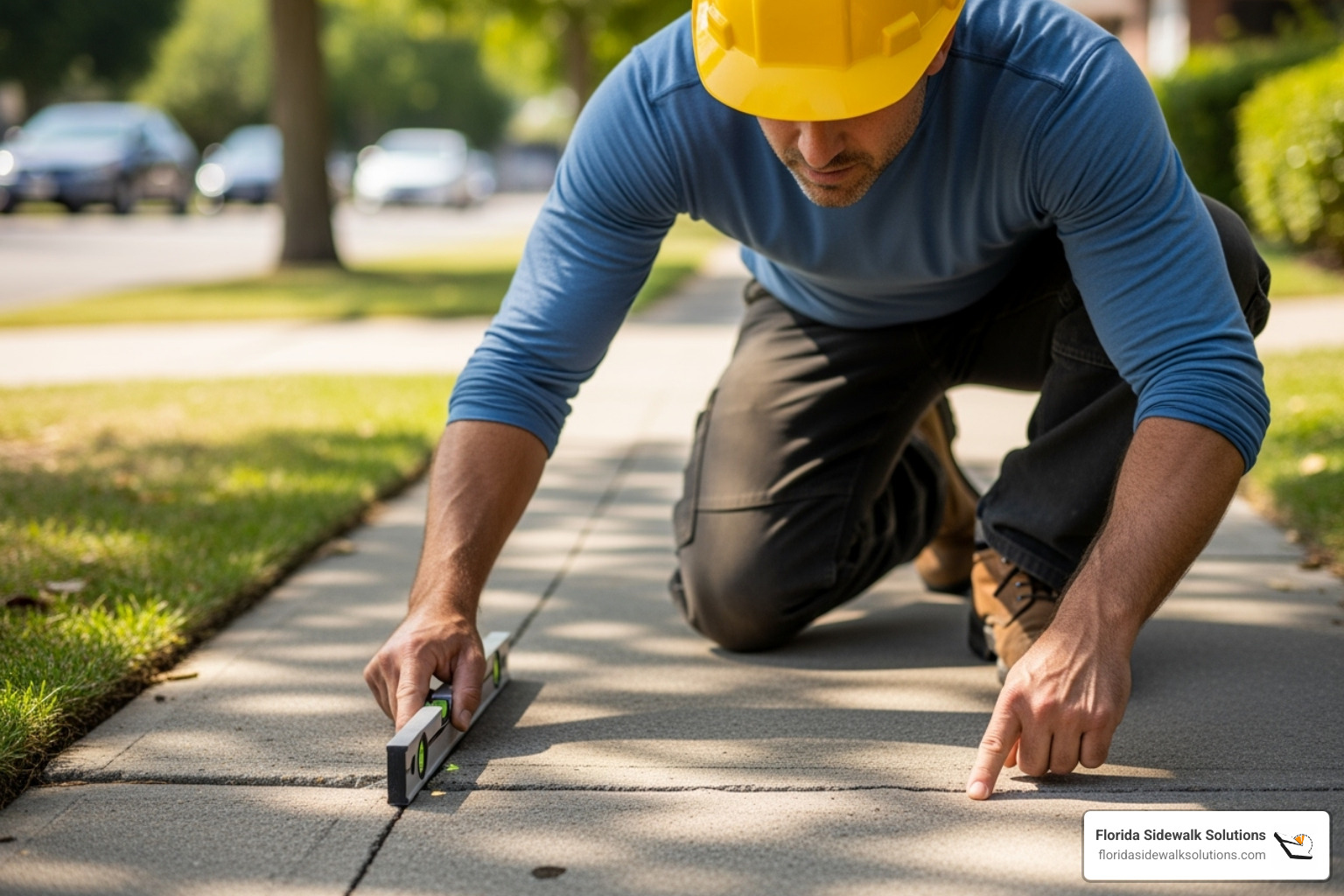
The difference between a general concrete contractor and a sidewalk trip hazard specialist is significant. While many contractors can pour a new driveway or install a patio, specialized trip hazard removal requires specific expertise, advanced equipment, and deep knowledge of ADA standards. You want someone who has dedicated their business to solving exactly the problem you’re facing.
When evaluating potential contractors, pay attention to their technology and equipment. Traditional methods like concrete grinding often leave edges unfinished and can’t reach tight spaces effectively. Ask if they use patented or proprietary methods that deliver superior results. Advanced cutting technology, like our precision concrete cutting system, offers cleaner, more complete repairs than conventional approaches.
Experience with ADA standards is absolutely non-negotiable. Your contractor should be able to explain the 1/4-inch rule for trip hazards without hesitation and demonstrate how their method ensures full compliance. They should also understand the liability implications of non-compliant sidewalks and the importance of eliminating hazards completely, not just reducing them.
Here are essential questions to ask any contractor you’re considering:
- How long have you specialized specifically in sidewalk trip hazard removal?
- Can you explain your repair method and why it’s effective for ADA compliance?
- Do you offer written guarantees on your trip hazard removal work?
- Can you provide before and after photos of similar projects?
- What’s included in your written estimate, and are there any potential additional costs?
Key Qualities for Your “Concrete Work Near Me” Search
The best sidewalk trip hazard specialists stand out through their focus on sidewalk trip hazard removal as a primary service offering. This isn’t something they do occasionally – it’s their specialty. Look for contractors who have invested in patented or proprietary methods rather than relying on outdated techniques that often fall short.
Before and after photos tell the real story of a contractor’s capabilities. A reputable specialist should eagerly share their portfolio, showing you the precise, clean results their method achieves. These photos should demonstrate complete hazard elimination, not just partial improvements.
Always insist on written estimates that detail exactly what work will be performed, what methods will be used, and all associated costs. Transparency in pricing reflects professionalism and helps you avoid unpleasant surprises later.
Service guarantees separate confident professionals from those who aren’t sure their repairs will last. A contractor who stands behind their work with a written guarantee demonstrates both skill and integrity.
Vetting Potential Contractors for Sidewalk Trip Hazard Repair
Start your research by checking local reputation through online reviews and Better Business Bureau ratings. Look for consistent praise regarding professionalism, efficiency, and lasting results. The BBB website can help you find accredited local contractors who meet higher standards for ethical business practices.
Asking for references from recent clients gives you direct insight into the contractor’s work quality and customer service. Focus on references from projects similar to yours, and don’t hesitate to ask specific questions about timeline, communication, and overall satisfaction.
Understanding the quote goes beyond comparing bottom-line prices. A detailed estimate should break down each phase of work, explain the repair method, and clarify what’s included. Ask about site preparation requirements, how they’ll match the repaired area to existing concrete, and what ongoing maintenance might be needed.
Confirming ADA knowledge protects you from contractors who might create attractive-looking repairs that still violate compliance standards. The right specialist should explain how their specific method addresses ADA requirements and eliminates liability concerns.
Avoiding lowball offers can save you from costly mistakes. Unrealistically low bids often indicate shortcuts, hidden costs, or inexperience that will cost you more in the long run. Quality sidewalk trip hazard repair is an investment in safety and compliance – choose based on value and expertise, not just price.
The right contractor will offer free inspections, transparent pricing, and clear explanations of their specialized approach to sidewalk trip hazard removal. Take your time to find someone who truly understands this specialized field.
Frequently Asked Questions about Sidewalk Concrete
When it comes to concrete work near me for sidewalk trip hazard repair, we hear certain questions over and over again. Understanding these fundamentals helps property owners make informed decisions about maintaining safe, ADA-compliant walkways. Let’s explore the most common inquiries we receive.
What is the difference between cement and concrete?
Here’s a question that stumps many people! While the terms get tossed around interchangeably at the hardware store, they’re actually quite different – and understanding this difference helps explain why quality matters so much in sidewalk construction.
Cement is just one ingredient in the bigger picture. Think of it as the “glue” that holds everything together. This fine, powdery substance comes from heating limestone, clay, and other minerals to extremely high temperatures, then grinding the result into that familiar gray powder. Portland cement is the most common type we see in sidewalk construction, prized for its strength and reliability.
Concrete is the complete package – the finished product you actually walk on. It’s a composite material that combines cement with water and aggregates (sand and gravel). A typical concrete mix breaks down to roughly 10% cement, 20% water, 30% sand, and 40% gravel or other coarse materials.
When water meets cement, a chemical reaction called hydration begins. This process causes the mixture to harden and bind all those aggregates together, creating the durable surface that can last decades when properly installed.
Water plays the starring role in this change. Too little water, and the concrete won’t cure properly. Too much, and you’ll end up with weak concrete that’s prone to cracking and settling – exactly the kind of problems that create trip hazards down the road.
This basic material science explains why proper installation matters so much for sidewalk longevity. When the original concrete work is done right, our precision cutting method can restore safety and ADA compliance while preserving that solid foundation for years to come.
What factors influence the cost of sidewalk trip hazard repair?
The cost of sidewalk trip hazard repair varies based on several practical factors, but our goal remains constant: providing the most effective and economical solution for your concrete work near me needs.
Severity of the trip hazard makes the biggest difference in complexity and cost. A minor 1/4-inch lip requires different precision than a dramatic 2-inch vertical displacement. Our patented cutting technology handles both scenarios, but more severe hazards naturally require more detailed work to achieve that perfectly level surface.
Linear feet of repair needed directly impacts your project cost. During our free site inspection, we carefully measure the total length of sidewalk sections requiring attention. This thorough assessment ensures accurate pricing with no surprises later.
The chosen repair method dramatically affects your bottom line – and this is where our approach truly shines. Traditional methods like full removal and replacement can cost ten times more than our precision cutting technique. Even conventional grinding methods can’t match our effectiveness, especially at sidewalk edges where trip hazards commonly occur.
Site accessibility influences how easily our specialized equipment reaches the repair areas. While our team handles projects in challenging locations, factors like remote access or significant obstacles might affect mobilization costs. Fortunately, our presence throughout South Florida keeps these expenses reasonable for most properties.
Mobilization fees cover transporting our patented equipment and experienced crew to your location. These costs stay efficient thanks to our strategic positioning to serve communities effectively.
We provide detailed, complimentary estimates after every thorough assessment. This transparency ensures you understand exactly what your project involves, with no hidden charges or unwelcome surprises.
How long does a concrete sidewalk typically last?
The longevity of concrete sidewalks might surprise you – these durable surfaces are built to withstand decades of foot traffic when properly installed and maintained.
Most concrete sidewalks last 30 to 50 years under normal conditions. This impressive lifespan reflects concrete’s inherent strength and resilience against daily wear and tear. However, this is just the baseline for well-constructed walkways.
With proper maintenance and sealing, sidewalks can exceed 100 years of service life. Regular sealing protects the surface from moisture penetration and chemical damage, while prompt attention to minor issues prevents small problems from becoming major trip hazards.
Climate impact varies by region, though Florida’s weather presents unique challenges and advantages. We don’t deal with harsh freeze-thaw cycles that plague northern climates, where water seeps into cracks, freezes, and expands to create significant damage. However, our intense sun, occasional heavy rains, and high humidity require different maintenance approaches.
Soil settlement effects often create the trip hazards we’re called to repair. Even perfectly installed concrete can develop unevenness when the ground beneath shifts or settles over time. This natural process doesn’t mean the concrete itself has failed – it simply needs professional attention to restore safety and compliance.
The importance of proper installation cannot be overstated. Quality ground preparation, correct water-to-cement ratios, adequate reinforcement, and proper curing all determine how well a sidewalk ages. Shortcuts during installation inevitably lead to premature problems and safety issues.
Regular maintenance and sealing every few years keeps concrete looking good and performing well. Simple steps like avoiding harsh chemicals and addressing small cracks promptly can add decades to a sidewalk’s useful life.
When properly maintained sidewalks do develop trip hazards due to natural settling, our precision cutting method restores safety without sacrificing the remaining decades of service life in that concrete. It’s a smart approach that maximizes your investment while ensuring ADA compliance and pedestrian safety.
Conclusion
When you search for concrete work near me for your sidewalks, you’re really looking for peace of mind. You want to know that pedestrians can walk safely, that you’re protected from liability, and that your property meets all the necessary standards. That’s exactly what we deliver.
Throughout this guide, we’ve shown you why proactive maintenance isn’t just smart—it’s essential. Those seemingly small trip hazards of 1/4 inch or more aren’t minor inconveniences. They’re accidents waiting to happen and lawsuits waiting to be filed. The good news? You don’t have to live with that risk.
Enhancing public safety starts with understanding what ADA compliance really means. It’s not just about following rules; it’s about creating spaces where everyone can move confidently and safely. When your sidewalks meet these standards, you’re not just avoiding penalties—you’re building a community that welcomes everyone.
The importance of choosing specialized contractors cannot be overstated. General concrete contractors might know how to pour a driveway, but sidewalk trip hazard removal requires specific expertise and technology. Our patented precision cutting method isn’t just different—it’s better. It’s more effective than grinding, less disruptive than replacement, and significantly more affordable than both.
What sets Florida Sidewalk Solutions apart is our commitment to doing things right the first time. No weeks of waiting for concrete to cure. No messy grinding that can’t reach the edges properly. No astronomical costs for complete replacement when targeted repair will do the job better. Just immediate results that last.
We understand that every day you wait to address trip hazards is another day of potential liability. That’s why we make the process as simple as possible—from our free inspection to our detailed estimate to our efficient repair work that lets people use the sidewalk immediately afterward.
Your sidewalks should work for you, not against you. They should be an asset that adds value to your property, not a liability that keeps you up at night worrying about lawsuits. With the right approach and the right contractor, that’s exactly what you’ll get.
Don’t let uneven concrete dictate your stress levels or your budget. Take control with a solution that’s proven, affordable, and immediate. Schedule your free sidewalk inspection and repair estimate today and find how easy it can be to transform problem walkways into safe, compliant pathways that serve your community well.

